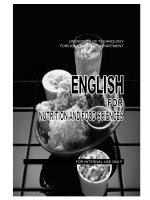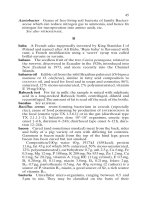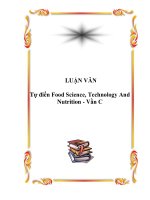Module 8 food chemistry, nutrition, and traditional foods
Bạn đang xem bản rút gọn của tài liệu. Xem và tải ngay bản đầy đủ của tài liệu tại đây (447 KB, 36 trang )
Module 8: Food Chemistry,
Nutrition, and Traditional Foods
Food: Any substances that can be
metabolized by an organism to give energy
and build tissue
Types: Carbohydrates, Proteins, Fats & Oils
Others: Vitamins, Minerals, Salts
Molecules of Food: Carbohydrates
6-C rings, 5-C rings
Mono-saccharides (sugar, fructose)
Dissacharides (lactose, sucrose)
Polysaccharides (starch, fibre, glycogen)
Carbohydrates are assimilated in the body
as “mono-saccharides” following digestion
Glucose: Body’s Primary Fuels
Lactic Acid + ATP + H2O
Glycogens
(Branched polymers
for short-term storage
in liver)
Glucose
(anaerobic)
(monomers)
(soluble)
Pyruvic Acid CO2 + H20 + ATP
(aerobic)
•Glucose level in blood stream is highly regulated
•Aerobic respiration is releasing 90% of the energy stored in
glucose
Glycogen
Anaerobic
Metabolism
Aerobic
Metabolism
Pyruvic Acid CO2 + H20 + 32ATP
Molecules of Food: Lipids and Fats
Fats: Large biological molecules, diverse
compositions, insoluble in water (i.e. non-polar in
nature)
Types:
–
–
–
–
Fatty acids (assimilable form)
Triglycerides (in blood)
Phospholipids (cell membranes)
Sterols (e.g. cholesterol)
Roles:
– Source of energy (during sustained activity)
– Structure of cell membrane
Free Fatty Acids (one chain)
• Saturated
• Unsaturated (e.g. Omega-3, Omega-6)
Fatty Acids
• Long-chain fatty acids (12+ carbons) are abundant
in meats and fish
• Short-chain fatty acids (12 carbons or less) are
abundant in dairy products
• Cold-water fish are rich in essential omega fatty
acids
• Unsaturated fatty acids, when cooked, change
conformation to a “trans” shape (which tend to
accumulate in blood vessels)
• Unsaturated fats are more prone to react with
oxygen, causing rancidity (common in stored fish)
Triglycerides
Phospholipids
• Phospholipids are “modified” triglycerides
where one fatty acid chain is replaced by a
phosphate group
• Soluble in water
• Important in cell membrane
Phospholipids
Sterols
• Multiple rings of carbon
• Best-known sterols: cholesterol (the
building block for all other sterols)
• Bile acids, some hormones, Vitamin C
Sterols
Cholesterol
Sitosterol (the most
abundant and common plant
sterol)
Absorption of Lipids
• Fat breakdown occurs in intestines
• Smaller units: fatty acids, glycerol, and
sterols
• Cholesterol and triglycerides are non-polar,
hence need “lipoproteins” to carry them in
the bloodstream
Molecules of Food: Proteins
• Chains of Amino Acids
• Diverse roles: enzymes, hormones,
regulators, molecular transports, antibodies,
building tissue like muscles, and energy
• Made up of C, H, O, N, other ions
Amino Acids
• Four components
around a central
carbon (C)
• One hydrogen
• An amino group (NH2)
• An acid (-COOH)
• A functional group
Glycine
Amino Acids
Essential Amino
Acid: Leucine
Non-essential
Amino Acid:
Asparagine
Molecules of Food: Vitamins
• Essential organic compounds to ensure
proper metabolism
• Little caloric value
• Water-soluble vitamins (enter directly into
bloodstream)
• Fat-soluble vitamins (must be transported
by carrier proteins)
• Several diseases are associated with vitamin
deficiencies
Caloric Contents of Food Molecules
Food Type
Caloric
%
Content (Cal/g) Recommended
Caloric Intake
Fats and Oils
9
30
Carbohydrates
4
58
Proteins
4
10
Vitamins
Trace
Not Applicable
Subsistence Food Provisioning
• Nutrition for indigenous people in the Arctic is
changing rapidly; from 100% to <50% “country
food”.
• Presence of larger communities, presence of “Coop” or “Bay” stores, and an increasing cash
economy contribute to changes in feeding habits.
• Lastly, hunting activities are costly when modern
technologies are used the “pay off” of
traditional food provisioning is decreasing.
Concepts
Subsistence activities: The hunting, fishing, and
gathering of local foods for consumption, sharing,
and trade or barter.
e.g. caribou, whales, seals, marine birds, waterfowls,
eggs, fruits (largely a carnivore diet)
Note: Commercial trapping or fishing is generally
not viewed as traditional food gathering; although
they could be traditional activities.
Example of Subsistence Food
Economy
Inupiat households in Barrow, Alaska









